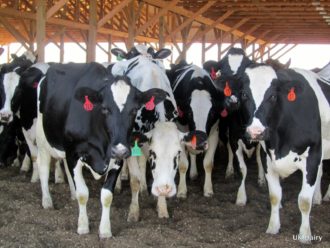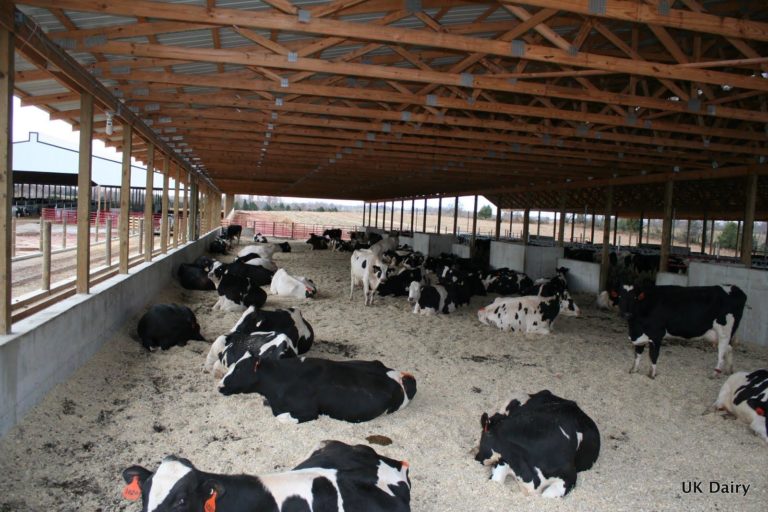LEXINGTON, Kentucky – A University of Kentucky dairy scientist is leading efforts to measure the incidences of mastitis – a common and costly dairy cattle disease – in a relatively new housing system that is gaining popularity among producers.
Jeffrey Bewley received a Southern Sustainable Agriculture Research & Education (SSARE) On-Farm Research Grant to compare levels of mastitis infections of lactating cattle in an innovative compost-bedded pack barn system versus the more conventional freestall barns.
“The goal is to determine how mastitis infections in compost-bedded systems stack up against mastitis incidences in the more conventional system, as well as identify the types of bacteria that are characterizing the infection so that farmers who are interested in this new housing system can better manage their herds against the disease,” said Bewley. The researcher, along with graduate student Elizabeth Eckelkamp, is working with 16 dairy producers across Kentucky in the study.
Many producers are making the switch from conventional freestall barns (covered stalls that provide animals with a clean, dry comfortable resting area) to compost-bedded pack barns -- loose-housing systems that offer a larger, less restrictive, more open resting area and are usually bedded with sawdust or wood shavings.
Bewley said that producers are interested in compost-bedded pack barns for the perceived improvement in cow comfort, lower investment costs, and their dual purpose as housing and compost storage.
“Animal wellbeing is one of the driving factors of using the system. Increased cow comfort equals more milk production. The system is also less expensive than freestall barns, as much as 60 percent of the price,” said Bewley. “In addition, as the cows add manure and urine to the wood shavings or sawdust, the mix eventually turns into compost that farmers can apply to their fields.”
Despite the housing system’s popularity, little research has been done to measure how much it contributes to the levels of mastitis infections. Mastitis is an inflammation of the mammary gland most frequently caused by a bacterial infection, and can be costly for dairy producers if left untreated because it affects milk yield. Bewley hopes to provide some answers with his SSARE-funded project, “Clinical Mastitis Incidence in Compost Bedded Pack Barns as Compared to Freestall Barns (OS13-070).”
“Conventional wisdom would tell you that cows resting in compost-bedded pack barns would have a higher incidence of mastitis because of their exposure to bacteria,” said Bewley. “But after visiting farms and talking with farmers who have the system, we are finding that’s not the case. There is more to it than that.”
He noted a study that recorded a reduction in Somatic Cell Count in one farmer’s dairy herd a year after installing compost-bedded pack barns. The severity of mastitis and corresponding milk quality is measured by Somatic Cell Count and quantified by the number of cells per milliliter of milk. Any cow with more than 200,000 cells per milliliter has some level of mastitis, said Bewley. The legal limit is 750,000 cells per milliliter.
“We want to measure the level of mastitis incidences in dairy herds using the compost-bedded pack system and compare those measurements with those found in the freestall barns,” said Bewley. “We are hypothesizing that mastitis incidences will be similar between the two systems.”
If those results hold true, compost-bedded pack barns would be a viable alternative for producers interested in the housing system for the myriad of benefits it provides.
Bewley also plans to characterize the bacteria associated with mastitis in the study.
“There are several types of bacteria strains that cause mastitis. Some are contagious and some are environmental in nature,” said Bewley. “Characterizing the bacteria in a compost-bedded pack barn will help producers better manage the disease by pointing out potential issues with the system.”
Some limitations currently exist with a compost-bedded pack barn system, said Bewley, such as a readily available supply of bedding material and the longer time it takes for the bedding to dry out in the winter.
“This system is much easier to manage in summer than in winter,” said Bewley, “which explains why the system has taken off here in the South. We don’t have a very long winter.”
Compost-bedded pack barns are popping up on dairy farms throughout Kentucky, as well as Virginia and Tennessee.
--30—
Published by the Southern Region of the Sustainable Agriculture Research and Education (SARE) program. Funded by the USDA National Institute of Food and Agriculture (NIFA), Southern SARE operates under cooperative agreements with the University of Georgia, Fort Valley State University, and the Kerr Center for Sustainable Agriculture to offer competitive grants to advance sustainable agriculture in America's Southern region.

